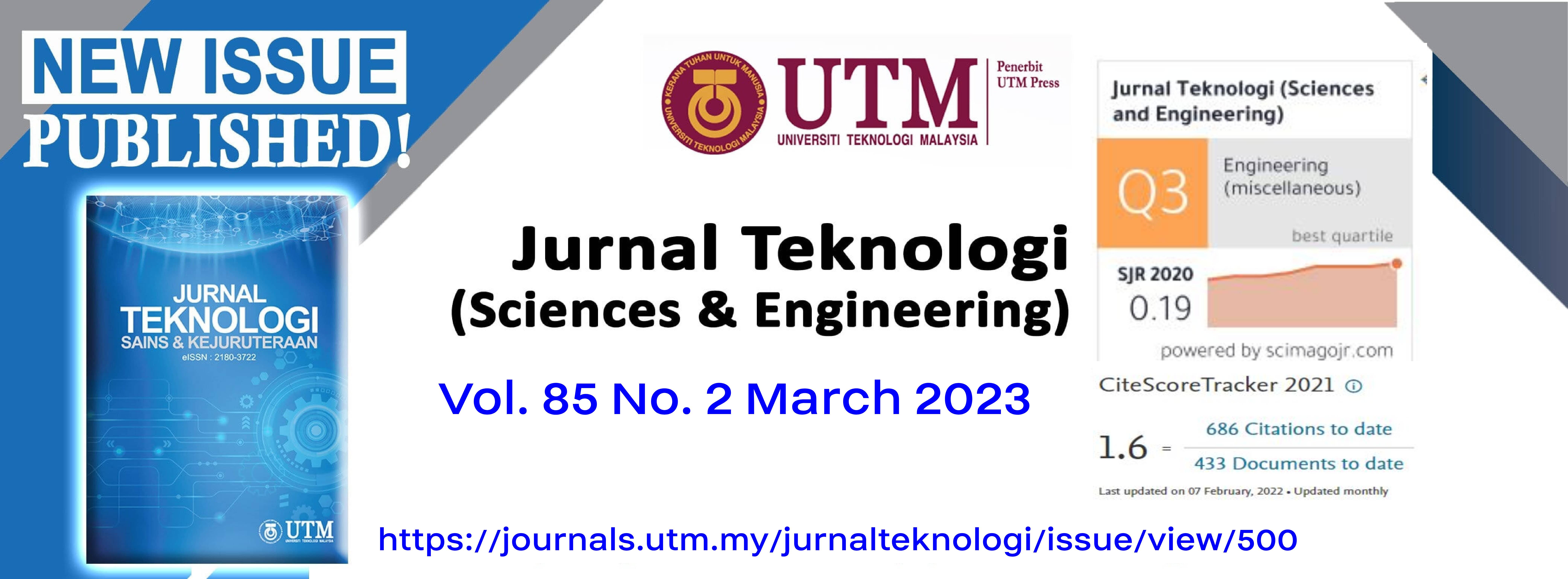EFFECT OF PRINT BED’S HEAT FLOW ON CURLING AND SURFACE ROUGHNESS OF FDM-PRINTED ABS SAMPLE
DOI:
https://doi.org/10.11113/jurnalteknologi.v85.18610Keywords:
Additive manufacturing, fused deposition modelling (FDM), acrylonitrile–butadiene–styrene (ABS), 3D laser scanner, dimensional accuracyAbstract
The optimization of printing parameters, in particular the print bed aspect, is essential for the further improvement of print quality. This paper investigates the effect of the print bed’s heat flow and surface properties (i.e. materials and surface roughness) on the curling defect and surface roughness of the ABS-based dog bone designed print. The print bed temperature is varied, and the corresponding heat flow is measured using a portable heat flow meter. The maximum z deflection (curling) of the print is characterized using Geomagic Control X metrology software by measuring the dimension deviation of the 3D scanned print compared with the CAD drawing. The surface roughness in terms of the Ra and Rz of the print are obtained by a stylus-based contact profilometer. The measured heat flow data have a positive linear correlation with the print bed temperature, which is confirmed by our theoretical calculation. The surface roughness of the print is higher when printed on the zinc plate-overlaid print bed, compared with the standard (unmodified) print bed. Furthermore, the applied heat flow has a large positive correlation with the print’s roughness but no correlation with the maximum z deflection. The roughness and z-deflection behaviour are attributed to the curling at the grip section of the print, resulting in a shorter interaction time with the print bed surface compared with the gage section that remains in physical contact throughout the 3D printing.
References
Jordan, J. M. 2019. 3D Printing. Cambridge: MIT Press.
Doi: https://doi.org/10.7551/mitpress/11800.001.0001.
Taha, M. M., Jumaidin, R., Razali, N. M. and Kudus, S. I. A. 2020. Green Material For Fused Filament Fabrication: A Review. In Mastura, M. T. and Sapuan, S. M. (eds.). Implementation and Evaluation of Green Materials in Technology Development: Emerging Research and Opportunities: Emerging Research and Opportunities. Hershey: IGI Global.
Ranganathan, R., Ravi, T. and Pugalendhi, A. 2019. Analysis of Shrinkage Compensation Factor (SCF) of FDM uPrint SE for Accuracy Enhancement. International Journal of Integrated Engineering. 11(1): 207-16.
Doi: https://doi.org/10.30880/ijie.2019.11.01.022.
Maidin, N. A. 2020. Design for Manufacturability (DFM) of 3D Printed Parts Fabricated Using Open Source 3D Printer. International Journal of Integrated Engineering. 12(5): 203-9.
Doi: https://doi.org/10.30880/ijie.2020.12.05.025.
Dilberoglu, U. M., Simsek, S. and Yaman, U. 2019. Shrinkage Compensation Approach Proposed for ABS Material in FDM Process. Materials and Manufacturing Processes. 34(9): 993-8.
Doi: https://doi.org/10.1080/10426914.2019.1594252.
Shirmohammadi, M., Goushchi, S. J. and Keshtiban, P. M. 2021. Optimization of 3D Printing Process Parameters to Minimize Surface Roughness with Hybrid Artificial Neural Network Model and Particle Swarm Algorithm. Progress in Additive Manufacturing. 1-17.
Doi: https://doi.org/10.1007/s40964-021-00166-6.
Mwema, F. M. and Akinlabi, E. T. 2020. Fused Deposition Modeling: Strategies for Quality Enhancement. Switzerland: Springer Nature.
Doi: https://doi.org/10.1007/978-3-030-48259-6.
Snapp, K. L., Gongora, A. E. and Brown, K. A. 2021. Increasing throughput in Fused Deposition Modeling by Modulating Bed Temperature. Journal of Manufacturing Science and Engineering. 143(9): 094502-7.
Doi: https://doi.org/10.1115/1.4050177.
Devicharan, R. and Garg, R. 2019. Optimization of the Print Quality by Controlling the Process Parameters on 3D Printing Machine. In: Kumar, L. J., Pandey, P. M., Wimpenny, D. I. (eds.). 3D Printing and Additive Manufacturing Technologies. Singapore: Springer. 187-94.
Doi: https://doi.org/10.1007/978-981-13-0305-0_16.
Schmutzler, C., Zimmermann, A. and Zaeh, M. F. 2016. Compensating Warpage of 3D Printed Parts using Free-Form Deformation. Procedia CIRP. 41: 1017-22.
Doi: https://doi.org/10.1016/j.procir.2015.12.078.
Armillotta, A., Bellotti, M. and Cavallaro, M. 2018. Warpage of FDM Parts: Experimental Tests and Analytic Model. Robotics and Computer-Integrated Manufacturing. 50: 140-52.
Doi: https://doi.org/10.1016/j.rcim.2017.09.007.
Kaushik, P. 2020. Introduction to Regression Analysis [using Excel] [Online]. Towards Data Science. Available: https://towardsdatascience.com/introduction-to-regression-analysis-using-excel-398ae1c3d604. [Accessed May 7th 2022].
Zaiontz, C. 2022. Real Statistics Resource Pack [Online]. Real Statistics Using Excel. https://www.real-statistics.com/free-download/real-statistics-resource-pack/. [Accessed May 7th 2022].
Quill, T. J., Smith, M. K., Zhou, T., Baioumy, M. G. S., Berenguer, J. P., Cola, B. A., Kalaitzidou, K. and Bougher, T. L. 2018. Thermal and Mechanical Properties of 3D Printed Boron Nitride – ABS Composites. Applied Composite Materials. 25(5): 1205-17.
Doi: https://doi.org/10.1007/s10443-017-9661-1.
Smith, W., and Hashemi, J. 2022. ISE Foundations of Materials Science and Engineering. 7th ed. New York: McGraw Hill.
Yunus, A., Cimbala, J. and Afshin, G. 2021. Fundamentals of Thermal-fluid Sciences. New York: McGraw Hill.
Halliday, D., Resnick, R. and Walker, J. 2021. Fundamentals of Physics. New York: Wiley.
Rosli, A. A., Shuib, R. K., Ishak, K. M. K., Hamid, Z. A. A., Abdullah, M. K., Rusli, A. 2020. Influence of Bed Temperature on Warpage, Shrinkage and Density of Various Acrylonitrile Butadiene Styrene (ABS) Parts from Fused Deposition Modelling (FDM). AIP Conference Proceedings. 2267(020072): 1-10.
DOI: https://doi.org/10.1063/5.0015799.
Sahay, C. and Ghosh, S. Understanding Surface Quality: Beyond Average Roughness (Ra). 2018 ASEE Annual conference & Exposition, Salt Lake City, US. 23-27 June 2018. 1-20.
Pérez, M., Medina-Sánchez, G., García-Collado, A., Gupta, M. and Carou, D. 2018. Surface Quality Enhancement of Fused Deposition Modeling (FDM) Printed Samples based on the Selection of Critical Printing Parameters. Materials. 11(8): 1382.
Doi: https://doi.org/10.3390/ma11081382.
Jo W., Kwon, O. –C and Moon M. -W. 2018. Investigation of Influence of Heat Treatment on Mechanical Strength of FDM Printed 3D Objects. Rapid Prototyping Journal. 24(3): 637-44.
Doi: https://doi.org/10.1108/RPJ-06-2017-0131.
Jo, W., Lee, J. S., Lee, H. J. and Moon, M. -W. 2014. 3D Printed Tactile Pattern Formation on Paper with Thermal Reflow Method. RSC Advances. 4(60): 31764-31770.
Downloads
Published
Issue
Section
License
Copyright of articles that appear in Jurnal Teknologi belongs exclusively to Penerbit Universiti Teknologi Malaysia (Penerbit UTM Press). This copyright covers the rights to reproduce the article, including reprints, electronic reproductions, or any other reproductions of similar nature.
















